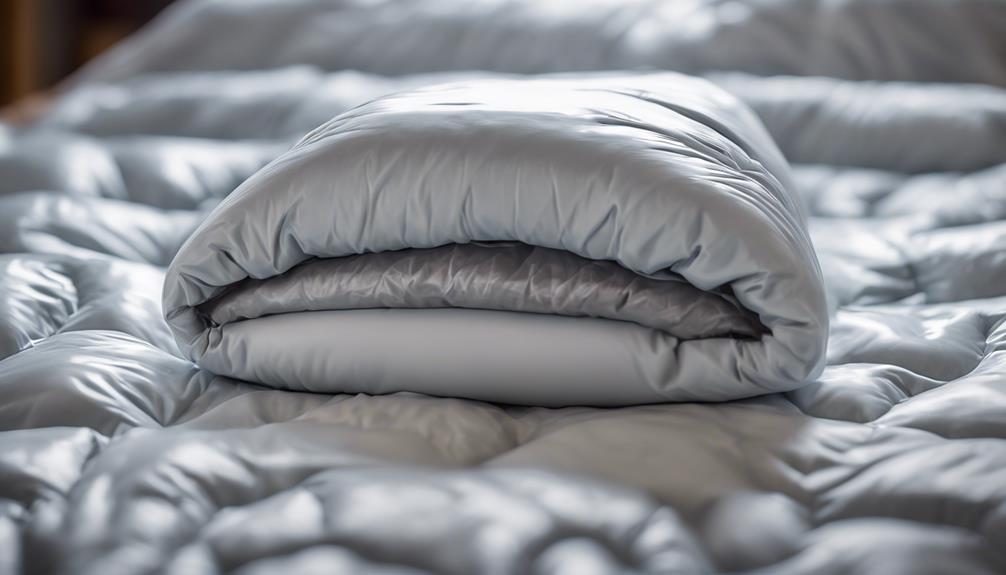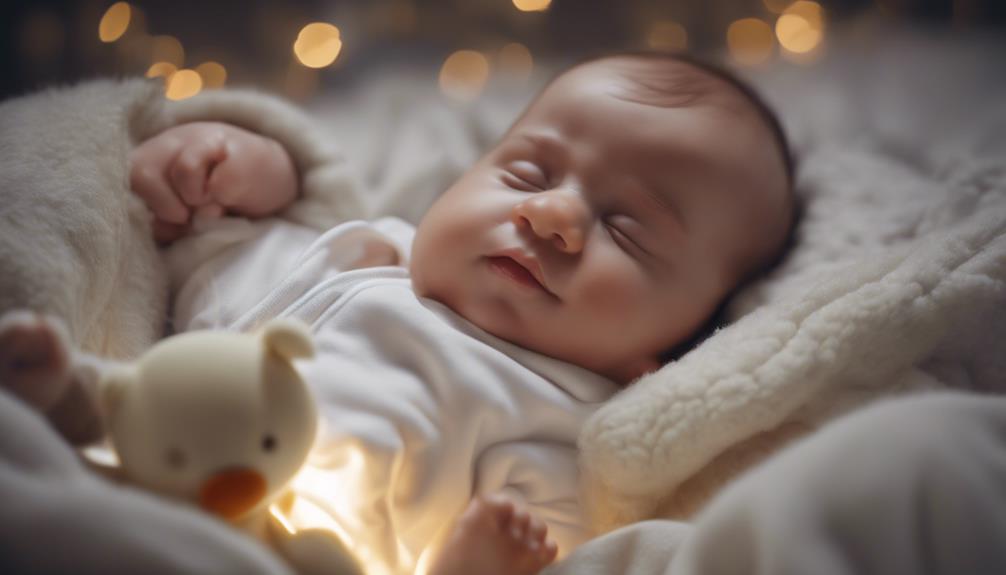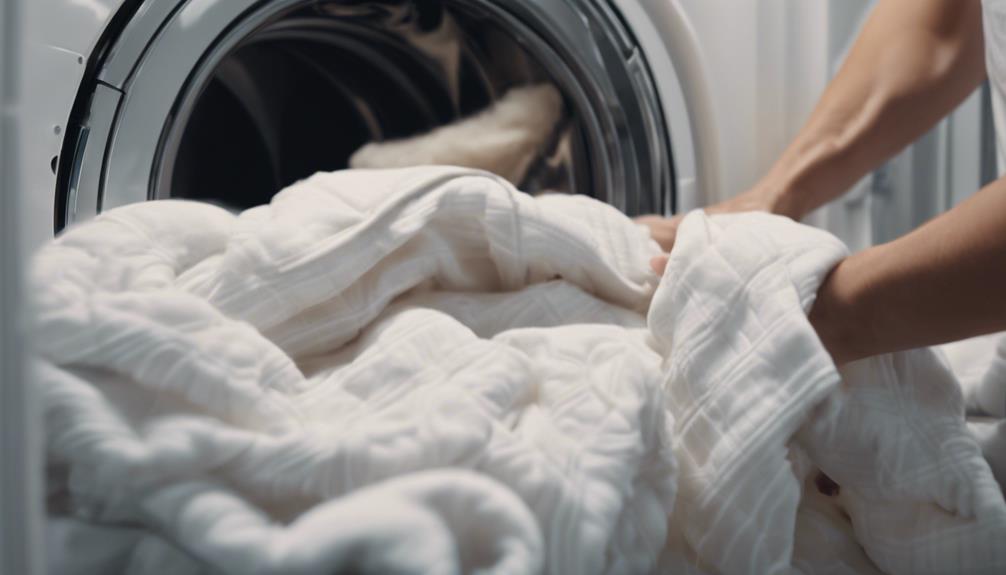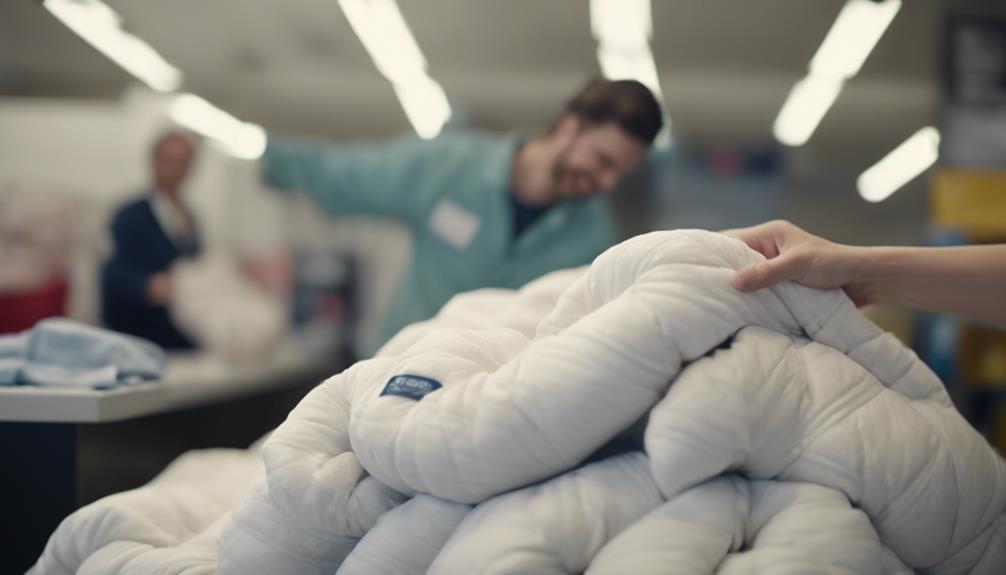Allergic reactions to down comforters are often caused by dust mites, dander, or mold—not the feathers themselves. Keeping your comforter clean and choosing hypoallergenic alternatives can help lessen discomfort. Symptoms may include sneezing, coughing, watery eyes, fatigue, and swelling. Regular cleaning and selecting high-quality materials are essential. If you would like to find out more about symptoms, causes, and prevention, useful information is accessible.
Key Takeaways
- Down comforter allergies are often due to dust mites, dander, or mold.
- Feathers themselves are not the main allergens in down comforters.
- Regular cleaning and proper maintenance can reduce allergic reactions.
- Hypoallergenic bedding covers and down alternative comforters are safer options.
- Consult an allergist for personalized solutions and treatment recommendations.
Understanding Down Comforter Allergy
When dealing with the issue of down comforter allergy, it's essential to differentiate between genuine allergies and common triggers like dust mites and dander. Genuine allergies to down comforters are relatively rare; most reactions are due to dust mites, dander, or mold.
Feather allergies, often mistaken for down comforter allergies, aren't common as feathers themselves aren't top allergens. Improper cleaning can lead to dust mite accumulation, triggering allergies in sensitive individuals.
Opting for hypoallergenic bedding or down alternative comforters can be a safer choice for those concerned about down comforter allergies. These alternatives are designed to minimize allergens and provide a comfortable sleeping environment.
Symptoms of Down Comforter Allergy

Experiencing symptoms of down comforter allergy, such as sneezing, coughing, and watery eyes, can indicate a reaction to dust mites and mold rather than feathers. While feather allergies are relatively rare, allergic reactions to down comforters are often triggered by these common allergens. Symptoms of down comforter allergy may resemble hay fever, causing fatigue and swelling upon waking. True allergy to down itself is uncommon.
If you find yourself sneezing uncontrollably, experiencing a persistent cough, or constantly battling watery eyes while using a down comforter, it's essential to contemplate the possibility of a reaction to dust mites or mold present in the bedding rather than the feathers. These symptoms can be managed by opting for hypoallergenic bedding and maintaining proper cleaning routines to minimize exposure to the allergens. By understanding the symptoms and their potential causes, individuals can take proactive steps to alleviate discomfort associated with down comforter allergies.
Causes of Down Comforter Allergy

When it comes to down comforter allergies, the main culprits are often dust mites and accumulated dust, rather than the feathers themselves. These common allergens in down can trigger symptoms like a runny nose, coughing, congestion, and a sore throat.
While genuine allergies to goose down feathers are rare, proper cleaning and maintenance of down comforters can help reduce the risk of allergic reactions associated with dust mites and dander.
Common Allergens in Down
Common allergens in down, such as dust mites and mold, are often the primary culprits behind down comforter allergies rather than the feathers themselves. Dust mites are microscopic pests that thrive in warm and humid environments, commonly found in feather bedding. These tiny creatures feed on dander, a skin particle shed by humans and pets, which can accumulate in down comforters.
Mold can also grow in the damp conditions that sometimes occur in bedding. While genuine allergies to goose or duck feathers are less common, it's the presence of dust mites and mold that usually triggers allergic reactions. Regular cleaning and proper maintenance of bedding can help reduce exposure to these allergens and alleviate symptoms of down comforter allergies.
Symptoms of Allergy
Dust mites and mold, common allergens found in down bedding, can trigger symptoms of allergy, such as a runny nose, coughing, congestion, and a sore throat. These symptoms are often mistaken for a cold or flu, but they can persist if the underlying cause, like an allergy to bedding, isn't addressed.
Allergic reactions to down comforters are usually due to dust mites and dust, not the feathers themselves. It's important to note that feather and dust mite allergies can have similar symptoms, leading to confusion about the root cause. While true allergies to goose feathers are rare in individuals with dust and dander allergies, managing down comforter allergies by using hypoallergenic bedding or taking antihistamines is recommended.
Diagnosis of Down Comforter Allergy

To accurately diagnose a down comforter allergy, identifying symptoms such as sneezing, coughing, itchy eyes, and congestion following exposure to the comforter is essential. An allergist can conduct skin prick tests or blood tests to pinpoint the specific allergens triggering reactions to the down comforter. It's vital to distinguish between genuine down feather allergies and responses to dust mites or mold that might be present in the comforter. Allergy testing aids in determining whether the symptoms stem from the down comforter or other allergens in the bedroom environment. Maintaining a detailed symptom log, noting when they occur concerning contact with the down comforter, can help in accurately diagnosing the allergy.
- Skin prick tests or blood tests are conducted by allergists to identify specific allergens.
- Distinguishing between down feather allergies and reactions to dust mites or mold is essential.
- Allergy testing helps determine if symptoms are linked to the down comforter or other bedroom allergens.
- Keeping a detailed symptom record assists in an accurate diagnosis.
- Identifying symptoms post-exposure is key to diagnosing a down comforter allergy.
Treatment Options for Down Comforter Allergy

In managing a down comforter allergy, one effective treatment option involves utilizing hypoallergenic bedding covers to create a barrier against allergens. Products like Pacific Coast AllerRest encasements provide a barrier fabric that prevents direct contact with dust mites and dander, reducing allergic reactions. These covers can be used for pillows, comforters, and mattresses to minimize exposure to allergens while sleeping.
Regular washing of bedding in hot water and drying on high heat can help eliminate dust mites from down comforters, further reducing allergy triggers. Additionally, vacuuming and cleaning the bedroom frequently can prevent allergen buildup, creating a cleaner environment for allergy sufferers.
For personalized advice and possible medication options, consulting with an allergist is recommended. They can offer tailored solutions to manage symptoms of down comforter allergies effectively. By combining these treatment options, individuals can alleviate discomfort and enjoy a more restful sleep without the worry of allergic reactions.
Prevention of Down Comforter Allergy

When preventing down comforter allergies, we should consider using hypoallergenic bedding covers, maintaining a regular cleaning routine, and using encasings for added protection.
These steps help reduce dust mites and allergens that trigger allergic reactions.
Hypoallergenic Bedding Options
Exploring the risks of down comforter allergies, delving into hypoallergenic bedding options becomes essential for maintaining a healthy sleep environment. Here are some options to ponder:
- Wool Bedding: Naturally resistant to dust mites, wool can reduce allergic reactions and regulate body temperature.
- Investing Wisely: Hypoallergenic bedding materials can prevent sneezing, coughing, and watery eyes, promoting restful sleep.
- Sustainability: Wool bedding offers an eco-friendly choice, lasting for years and reducing allergic risks.
- Quality Matters: High-quality wool bedding provides long-term comfort and value, enhancing sleep quality.
- Organic Cotton: Free from harmful chemicals, organic cotton bedding is gentle on the skin, preventing allergic reactions effectively.
Regular Cleaning Routine
Exploring ways to prevent down comforter allergies, maintaining a regular cleaning routine is key to minimizing allergens and ensuring a healthy sleep environment. Washing the bedding regularly in hot water helps eliminate dust mites and allergens that can trigger allergies.
Drying the comforter on high heat can further aid in reducing these allergy triggers. Vacuuming and airing out the comforter as well can prevent dust mites from accumulating. It's also beneficial to follow the manufacturer's instructions for cleaning and maintenance to minimize allergic reactions to the comforter.
Encasing for Protection
Encasing your down comforter in a protective cover provides a barrier against allergens like dust mites and dander, aiding in preventing allergic reactions.
- Allergy-proof encasements help block allergens from infiltrating the comforter.
- Encasing your down comforter reduces the risk of allergy symptoms such as sneezing and congestion.
- Quality encasements are breathable, allowing airflow while keeping allergens out.
- Using an encasement is a proactive step toward creating a healthier sleep environment.
- Consider sustainable products when choosing an encasement to benefit both your health and the environment.
Managing Down Comforter Allergy

To effectively manage down comforter allergies, regular washing of bedding covers and pillows is essential to prevent allergic reactions caused by dust mites and mold. Dust mites and mold thrive in warm, humid environments, making down comforters a cozy home for these allergens.
Using sustainable products made of high-quality materials can also help reduce allergic triggers. Opting for quality and sustainable products can decrease the likelihood of allergic reactions caused by dust mites and mold.
Symptoms of down comforter allergies, such as red, watery eyes, stuffy nose, coughing, and congestion, can be alleviated by maintaining a clean sleeping environment. Feather allergies are rare, with dust mites and dander being the main culprits of allergic responses.
Ensuring proper washing and changing of bedding on a regular basis is vital to mitigating allergy risks associated with down comforters. By incorporating these practices, individuals can enjoy the comfort of a down comforter without the discomfort of allergies.
Conclusion and Recommendations

In light of the discussed facts, it's evident that proper care and consideration in bedding choices are essential for managing down comforter allergies effectively. To conclude, we recommend the following:
- Opt for sustainable products that promote eco-friendly practices in down comforter production.
- Consider investing in hypoallergenic bedding to minimize allergic reactions.
- Regularly clean and maintain your bedding to reduce dust mites and allergen buildup.
- Explore down alternative comforters as a viable option for those sensitive to traditional down feathers.
- Consult a medical professional if severe allergic reactions persist, ensuring proper guidance and management.
Frequently Asked Questions
Can You Be Allergic to a Down Comforter?
Yes, you can be allergic to a down comforter, although it's not common. Symptoms like coughing, congestion, and runny nose are often due to dust mites and dust, not feathers.
Allergies to down comforters are usually triggered by dust mites and other allergens rather than the down itself.
Opt for hypoallergenic bedding or antihistamines to manage any allergic reactions effectively. It's important to address the underlying allergen trigger for relief.
How Do You Know if You're Allergic to Down Feathers?
If we suspect an allergy to down feathers, common symptoms may include skin rashes, itching, or respiratory issues like coughing and wheezing.
To confirm, consulting an allergist for specific tests is key.
Opting for hypoallergenic bedding or down-free comforters can be helpful.
Remember, genuine allergies to down feathers are rare, often mistaken for reactions to dust mites or mold.
Always seek professional advice for proper diagnosis and management.
Is Down Comforter Hypoallergenic?
Yes, down comforters can be hypoallergenic if they undergo thorough cleaning processes to minimize allergens. Genuine allergic reactions to down itself are rare, with most allergies being triggered by dust mites and dander.
Down alternative comforters made of synthetic materials are often recommended for allergy sufferers. Regular cleaning and proper maintenance can help reduce the risk of allergic reactions to down comforters.
How Do I Know if I'm Allergic to My Bedding?
When wondering if you're allergic to your bedding, look for symptoms like sneezing, itching, or a rash upon waking up. These signs could point to a reaction to dust mites or other allergens in your bedding.
Consider using hypoallergenic bedding or consult a doctor for allergy testing to determine the specific triggers. Managing bedding allergies may involve regular cleaning, using allergen-proof covers, or taking antihistamines for relief.
Is Night Sweating a Common Symptom of Down Comforter Allergy?
Night sweating can be a common symptom of down comforter allergy. Some individuals may experience excessive sweating during sleep when using a down comforter. This could indicate an allergic reaction to the feathers or dust mites present in the comforter. If night sweats persist, it is recommended to switch to hypoallergenic bedding options.
Conclusion
To sum up, experiencing discomfort from a down comforter allergy can be challenging, but there are ways to manage and prevent it. By understanding the symptoms, causes, diagnosis, and treatment options, individuals can take steps to alleviate their allergies.
It's crucial to prioritize comfort and health when selecting bedding options to guarantee a restful night's sleep. Remember, knowledge is key in combating down comforter allergies.









